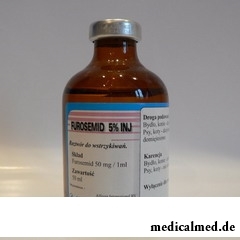





Furosemide
Application instruction:
Furosemide – synthetic diuretic medicine for treatment of an edematous syndrome.
Pharmacological effect of Furosemide
Active component of Furosemide  has diuretic effect, promoting the strengthened removal of water with simultaneous increase in removal of calcium ions and magnesium.
has diuretic effect, promoting the strengthened removal of water with simultaneous increase in removal of calcium ions and magnesium.
At use of Furosemide against the background of heart failure there is a bystry decrease in preload of the heart caused by expansion of large veins.
After intravenous administration effect of Furosemide comes quickly – in 5-10 minutes, after intake – on average in an hour.
Duration of diuretic effect of Furosemide reception – two-three hours, and at reduced function of kidneys effect of the medicine can proceed till eight o'clock.
Release form
The drug Furosemide is produced in a look:
- Granules for preparation of suspension for intake (for use in pediatrics), in banks on 150 ml and bags;
- Solution for intravenous and intramuscular administration, in ampoules on 2 ml;
- Tablets on 40 mg.
Indications to Furosemide use
According to the instruction Furosemide is appointed at treatment of an edematous syndrome of various genesis, including states at:
- Cirrhosis (syndrome of portal hypertensia);
- Chronic heart failure of the II-III stage;
- Nephrotic syndrome.
Besides, Furosemide according to the instruction is applied at:
- To cardiac asthma;
- Fluid lungs;
- Eclampsias;
- Wet brain;
- Arterial hypertension of a heavy current;
- Carrying out an artificial diuresis;
- Hypercalcemias;
- Some forms of hypertensive crisis.
Contraindications
Use of Furosemide according to the instruction is contraindicated in the following cases:
- At an urethra stenosis;
- At an acute glomerulonephritis;
- Against the background of an acute renal failure with an anury;
- At obstruction of urinary tract stone;
- At a hyperuricemia;
- At an alkalosis;
- At an acute myocardial infarction;
- At a hypopotassemia;
- Against the background of a heavy liver failure;
- In prekomatozny states;
- At a diabetic coma;
- At arterial hypotension;
- At a hepatic coma and a prekoma;
- At a hyper glycemic coma;
- At a dekompensirovanny mitral or aortal stenosis;
- At gout;
- At increase in the central venous pressure (more than 10 mm hg);
- Against the background of a hypertrophic subaortic stenosis;
- At digitalis intoxication;
- At disturbance of water and electrolytic exchange, including a hyponatremia, a hypovolemia, a hypochloraemia, a hypocalcemia, a hypopotassemia, a hypomagnesiemia;
- At pancreatitis;
- At hypersensitivity to Furosemide.
Furosemide is appointed with care to people of advanced age, especially with the expressed atherosclerosis, at pregnancy and a lactation, and also against the background of the following diseases:
- Hypoproteinemia;
- Prostate hyperplasia;
- Diabetes mellitus.
Furosemide route of administration
As a rule, the dosage and frequency rate of use of Furosemide is established by the doctor individually and depends from:
- Clinical situation;
- Indications;
- Age of the patient.
At Furosemide reception inside the adult initial dose varies from 20 to 80 mg a day which can be gradually increased to 600 mg a day.
The children's single dose of Furosemide is calculated proceeding from body weight and makes 1-2 mg on 1 kg, but no more than 6 mg/kg.
The Furosemide dose for adults at intravenous (jet) or intramuscular administration should not exceed 40 mg a day (in rare instances – to 80 mg divided into two times).
Reception of Furosemide at pregnancy is possible only during the minimum term taking into account estimated risk from use of medicine.
Medicinal interaction
Some medicinal  combinations with Furosemide can result in undesirable therapeutic effect that should be considered at the carried-out therapy.
combinations with Furosemide can result in undesirable therapeutic effect that should be considered at the carried-out therapy.
At simultaneous use of Furosemide with:
- Antibiotics of group of cephalosporins – the risk of strengthening of nephrotoxicity increases;
- Antibiotics of group of aminoglycosides – strengthening of ototoksichesky and nephrotoxic action is possible;
- Hypoglycemic means and insulin – decrease in their efficiency is possible;
- Including тербуталин, Fenoterolum, salbutamol and with glucocorticoids – can be observed by beta-adrenergic agonists strengthening of a hypopotassemia;
- Phenytoinum – diuretic effect of Furosemide sharply decreases;
- Indometacin and other non-steroidal anti-inflammatory drugs – decrease in diuretic effect is possible;
- Astemizol – the risk of development of arrhythmias increases;
- APF inhibitors – observe strengthening of anti-hypertensive action;
- Kolestipol and Colestyraminum – observe reduction of absorption and diuretic effect of Furosemide;
- Lity a carbonate – strengthening of effect of drug;
- Digitoxin and digoxin – increase in toxicity of cardiac glycosides is possible;
- Cisplatinum – strengthening of ototoksichesky action;
- Tsizaprid – observes strengthening of a hypopotassemia.
Side effects of Furosemide
At use of Furosemide according to indications there can be disturbances of cardiovascular system expressed as arrhythmias, a lowering of arterial pressure, a collapse, orthostatic hypotension and tachycardia.
Furosemide according to reviews can lead to the disturbances of a nervous system which are shown as:
- Dizziness;
- Myasthenia;
- Drowsiness;
- Headache;
- Paresthesias;
- Spasms of gastrocnemius muscles;
- Adynamia;
- Confusion of consciousness;
- Apathy;
- Slackness;
- Weakness.
Besides, Furosemide according to reviews can bring to:
- To vision disorders and hearing (sense bodys);
- To decrease in a potentiality, acute ischuria (especially against the background of a prostatauxe), a hamaturia, intersticial nephrite (urinogenital system);
- To exacerbation of pancreatitis, nausea, dryness in a mouth, to a loss of appetite, vomiting, thirst, cholestatic jaundice, locks or diarrhea (alimentary system);
- Hypovolemia, hypopotassemias, hyponatremias, hypochloraemia, hypocalcemia, hypomagnesiemia, metabolic alkalosis (water and electrolytic exchange);
- To leukopenia, agranulocytosis, thrombocytopenia, aplastic anemia (system of a hemopoiesis);
- Muscular weakness, arterial hypotension, hyperglycemia, dizziness, hyperuricemia with a possible exacerbation of gout, to spasms (metabolism).
Also at use of Furosemide according to indications with predisposition there can be such allergic reactions as a photosensitization, a mnogoformny exudative erythema, a purpura, a vasculitis, a small tortoiseshell, fever, exfoliative dermatitis, a fever, an acute anaphylaxis, a necrotizing angiitis and a skin itch.
At intravenous administration Furosemide according to reviews can cause calcification of kidneys (generally in premature children) and thrombophlebitis.
Storage conditions
According to indications Furosemide is released from drugstores on medical appointment. A period of storage – up to three years.
Name of drug
Price
Drugstore
Sofarm furosemide тбл 40 mg No. 20, Sopharma JSC
23 rub.
 Network of the Moscow drugstores of IFC
Network of the Moscow drugstores of IFCThe 74-year-old resident of Australia James Harrison became blood donor about 1000 times. It has a rare blood group which antibodies help to survive the newborn with a severe form of anemia. Thus, the Australian saved about two million children.

Bees – really unique beings. Practically all products of their life activity are used by the person. Since the most ancient times from...
Section: Articles about health
The modern person not always manages to find housing in the environmentally friendly region and such work which would not do harm to health. With food stuffs at first sight the situation is much better: shops are overflowed with goods which are positioned пр...
Section: Articles about health
Contrary to popular belief, the multiple sclerosis (MS) is not connected neither with sclerous changes of walls of vessels, nor with age forgetfulness and problems with concentration of attention. This disease has the autoimmune nature. Pathological process is expressed in degradation of nervous tissue and destruction of its enveloping layer - a myelin. Multiple damages of the central nervous system which are shown by decrease in sight, bystry fatigue, on become result of development of an illness...
Section: Articles about health
Olive oil – the product capable to make a powerful contribution to health of the person if it includes it in the diet. Rich vitamin...
Section: Articles about health
The main role in development of a peptic ulcer of a stomach and duodenum the bacterium Helikobakter plays pilor. Activity and the strengthened reproduction of this microorganism lead to weakening of protection of mucous membranes and their erosive damage. Manifestations not...
Section: Articles about health
Modern footwear is extremely various. It stopped being only protection for legs long ago. Today shoes, boots, barefoot persons choose not so much proceeding from their convenience and functionality how many being guided by outward, brand and an opportunity to add with them a stylish dress. At the same time, buying footwear, think of its safety a little. Meanwhile, many popular models can do essential harm to health....
Section: Articles about health
The sclera and mucous membrane of an eye are intensively supplied with blood vessels which problem - to sate nervous tissues of body to a pitata...
Section: Articles about health
For the last decades the diabetes mellitus of the second type became really world problem. The number of cases annually increases, and average age of patients for whom the illness is diagnosed, steadily decreases. Specialists consider that one of osno...
Section: Articles about health
It is pleasant to state a possibility of improvement of quality of life of people with problems of functioning of secretory system. Efforts of talented inventors created products which will be able to provide normal life activity of clients with moderate degree of a disease, it is essential to facilitate the help to patients with strongly expressed disturbances....
Section: Articles about health
For the person who daily since morning gathers for work it is very important to wake up vigorous and ready by day of work. On most...
Section: Articles about health
Statistically, at the address to doctors seven of each ten patients complain of a headache. Actually it is much more people who are periodically feeling unpleasant feelings such. Many people, apart from a headache the reason for serious fear...
Section: Articles about health
All like to sing. Small children with pleasure are engaged in a vocal, not especially thinking of hit in a melody. Adults most often hesitate, being afraid to show lack of talents in this area, and it is vain: singing is very useful for health....
Section: Articles about health
A lot of things depend on a condition of a backbone in a human body, a backbone - not only a support for a body, it also contain...
Section: Articles about health
Several decades ago the basil (the district khan, реан, Reagan) was considered as a part of the Caucasian or east cuisine, but today it strongly took the place on tables of Russians. Greens of this plant possess a strong, pleasant smell and specific fresh taste, because of to...
Section: Articles about health
Aging — natural and inevitable process. Over time our skin loses elasticity, on it saggings are formed, the face form loses former clearness. The procedure of nitevy lifting (nitevy tightening) can successfully solve this problem. In order that it is better to get acquainted with this popular procedure, we will tell you 6 cognitive facts about it....
Section: Articles about health
Any of us is not insured from a heavy illness of the loved one. Happens and so that someone from family members becomes lying бо...
Section: Articles about health
The next flu epidemic leads to the next panic, from year to year we give in on these manipulations: professionally alarming voice of the announcer in news, reports with calculation of the died patients, an interview with people in white dressing gowns and advertizing of anti-influenza means ра...
Section: Articles about health
Traveling all over the world, many try to try the most exotic dishes of national cuisines. There is even a so-called gastronomic tourism which, according to gourmets, not only allows to receive new feelings, but also is capable to show life of other people from absolutely unexpected side....
Section: Articles about health
"Epilepsy" doctors made the diagnosis in antique times. Displays of an illness and pattern of its development are very well studied. Odes...
Section: Articles about health
Venereal diseases in medicine are called the infections which are transmitted preferential sexually, now they and are called - infections, sexually transmitted, or STD. Among them is also life-threatening. In spite of the fact that majority...
Section: Articles about health
What will only not be thought up by persons interested to have a beautiful figure. Here the last innovation – for weight loss needs to be eaten greasy food. Let's understand whether there is at a fatty diet common sense....
Section: Slideshow
Life does not indulge the modern woman special emotional comfort and carelessness. Fatigue, troubles at work, misunderstanding...
Section: Articles about health
Proofs of efficiency of Mildronate at treatment of coronary heart disease with stenocardia can be found in many publications of the end of the twentieth century. Researches were conducted since 1984, including placebo - controlled effects. In total клиничес...
Section: Articles about health
History of use of an anesthesia during operations contains more than 160 years. Annually in the world hundreds of thousands of surgical interventions during which to patients the substances immersing them in a dream and saving from pain are entered are carried out. Using an anesthesia many myths and delusions are still connected. It is worth getting acquainted with the most widespread of them....
Section: Articles about health
About influence of fasting days on an organism it is told much – both about advantages, and about shortcomings. It is considered that fasting day...
Section: Articles about health
White teeth and the Hollywood smile – a dream of many people. Long time was considered that the plaque on teeth and change of their color – destiny of those who incorrectly eat smokes and badly brushes teeth. But the paradox is available: at everything the variety of toothpastes existing today...
Section: Articles about health
Neurosis is called pathology of a nervous system at which deviations in functioning of the highest nervous processes are observed. Most often - owing to yet not strengthened mentality - children are subject to neurosises. The unhealthy, hostile atmosphere in collective, a family, the strong and sharp shock, and also a set of other factors which negatively influence the little person who did not learn to overcome stresses yet can become premises to emergence of such disturbances....
Section: Articles about health

